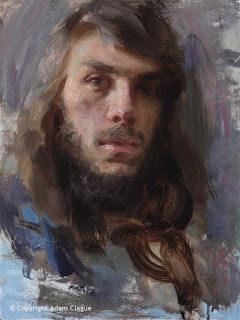
Left: An early student drawing of mine
Right: A more recent oil painting
Right: A more recent oil painting
I'll be transparent—I'm a perfectionist. I iron my jeans. I have a hard time focusing in a cluttered studio. I quintuple-check these lessons for typos (and kick myself when one gets past me). For years, my perfectionism was a huge hindrance to my painting—by the time I got everything just right, it was way too tight!
Now, please don't misunderstand me—there is nothing wrong with fully-rendered or "tight" paintings. Just look at the masterpieces of artists like William-Adolphe Bouguereau, Lawrence Alma-Tadema and Lord Frederic Leighton! Tight painting is only an issue if you want your paintings to look loose.
And man, did I want to paint loosely like John Singer Sargent and Richard Schmid! My paintings may never be on a par with those masters, but my work finally developed the looseness I desired.
This perfectionist learned to paint more loosely by disciplining myself to adopt these 6 practices:

- Stand
up. Sitting will keep you from frequently backing away from your
work. This is an essential habit, as problems are much more evident at a
distance. If you're unable to stand while painting, sit in a chair with
wheels.
- (Following from the last point) Adopt the 10-Foot Rule: If it reads well from 10 feet away, it's good—don't touch it!
- Envision
your subject made up of shapes like mosaic tiles. As much as possible,
try to paint these shapes with one stroke each. If you need to adjust a
shape, do so with a separate, deliberate stroke instead of continuing to
dab at it. Painting a shape with a single stroke often requires a
generous amount of paint on your brush, which leads me to the next
point…
- Mix up large batches of paint on your palette with your palette knife. One of the biggest culprits of tight painting is not using enough paint—when your brush is hungry for paint, multiple strokes are needed to cover an area, and this can cause the surface to look overworked.

- Use a brush slightly too big for the job (I couldn't find what artist said this, but if you know, please remind me!).
- Continuously ask yourself, "How do I want this to look?" Having at least a semi-clear vision for your brushwork can keep you from falling into the trap of slavishly copying your subject.
See My Loose Painting
Techniques on Video!
(Click image to view full-size)
Watch me demonstrate all kinds of loose brushwork in my Online Video Course! In over 10 hours of video instruction, you'll see my painting process from start to finish. Each lesson is a stepping stone to guide you toward
making better paintings. I can't wait to help you capture the beauty of your subjects faithfully and artistically! Access to the course will become available for purchase on October 7, 2019, but you can start the course today for FREE! For more information, please click the button below.
|
Asking "How do I want this to look?" is a key for beginning to find your personal style or "voice." I'll discuss that in the next lesson, How to Find Your Artistic Voice.
—Adam





Fantabulous! Just picked up a beautiful light weight New Wave wood palette to balance on my waist and a bunch of big flat brushes at the PSoA conference to try out. (I went to the Filbert School). Dianne da Silva
ReplyDeleteHi, I'm surprised by the style and technique of painting that you presented on Instagram and I decided to visit this blog. I'll be back to see one, another when I have more time! Good evening from Bonn, where I work!
ReplyDeletehttps://popeyjazz.blogspot.com/